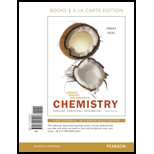
GENERAL ORGANIC+BIO...(LL)-W/MOD.ACCESS
3rd Edition
ISBN: 9780134466699
Author: FROST
Publisher: PEARSON
expand_more
expand_more
format_list_bulleted
Concept explainers
Question
Chapter 2, Problem 2.3PP
Summary Introduction
To determine:
A comparison between the mass of an electron and the mass of a proton.
Introduction:
Electrons are the negatively charged species that revolve around the nucleus in stationary orbits.
Protons are the positively charged species present inside the nucleus that is located at the center of an atom.
Expert Solution & Answer
Want to see the full answer?
Check out a sample textbook solution
Students have asked these similar questions
help me solve this hw
can you please help me solve hw
Give a brief comparison of chemical potential and electrochemical potential.
Chapter 2 Solutions
GENERAL ORGANIC+BIO...(LL)-W/MOD.ACCESS
Ch. 2 - Where are the subatomic particles located in an...Ch. 2 - Prob. 2.2PPCh. 2 - Prob. 2.3PPCh. 2 - Prob. 2.4PPCh. 2 - How can you determine the following? a. the number...Ch. 2 - What can be determined from the following? a. the...Ch. 2 - Provide the name and atomic symbol of the element...Ch. 2 - Provide the name and atomic symbol of the element...Ch. 2 - Prob. 2.9PPCh. 2 - Prob. 2.10PP
Ch. 2 - Determine the number of protons, neutrons, and...Ch. 2 - Determine the number of protons, neutrons, and...Ch. 2 - Prob. 2.13PPCh. 2 - Prob. 2.14PPCh. 2 - Prob. 2.15PPCh. 2 - Prob. 2.16PPCh. 2 - Prob. 2.17PPCh. 2 - How are atomic mass and mass number similar? How...Ch. 2 - There are three naturally occurring isotopes of...Ch. 2 - Prob. 2.20PPCh. 2 - Prob. 2.21PPCh. 2 - Prob. 2.22PPCh. 2 - Prob. 2.23PPCh. 2 - Prob. 2.24PPCh. 2 - Prob. 2.25PPCh. 2 - Prob. 2.26PPCh. 2 - Prob. 2.27PPCh. 2 - Prob. 2.28PPCh. 2 - Prob. 2.29PPCh. 2 - Prob. 2.30PPCh. 2 - Prob. 2.31PPCh. 2 - Prob. 2.32PPCh. 2 - What does the unit sievert measure?Ch. 2 - Prob. 2.34PPCh. 2 - Prob. 2.35PPCh. 2 - Prob. 2.36PPCh. 2 - Prob. 2.37PPCh. 2 - Prob. 2.38PPCh. 2 - Prob. 2.39PPCh. 2 - Prob. 2.40PPCh. 2 - Prob. 2.41PPCh. 2 - Prob. 2.42PPCh. 2 - Prob. 2.43PPCh. 2 - Prob. 2.44PPCh. 2 - Complete the following statements: a. A...Ch. 2 - Complete the following statements: a. The mass...Ch. 2 - Prob. 2.47APCh. 2 - Prob. 2.48APCh. 2 - Prob. 2.49APCh. 2 - Prob. 2.50APCh. 2 - Prob. 2.51APCh. 2 - Prob. 2.52APCh. 2 - Prob. 2.53APCh. 2 - Prob. 2.54APCh. 2 - Prob. 2.55APCh. 2 - Prob. 2.56APCh. 2 - Prob. 2.57APCh. 2 - Prob. 2.58APCh. 2 - Prob. 2.59APCh. 2 - Prob. 2.60APCh. 2 - Prob. 2.61APCh. 2 - Prob. 2.62APCh. 2 - Prob. 2.63APCh. 2 - Prob. 2.64APCh. 2 - Prob. 2.65APCh. 2 - Prob. 2.66APCh. 2 - Prob. 2.67APCh. 2 - Prob. 2.68APCh. 2 - A 25-mL sample of chromium-51 contains 1.00 mCi....Ch. 2 - Prob. 2.70APCh. 2 - Prob. 2.71APCh. 2 - Prob. 2.72APCh. 2 - Prob. 2.73APCh. 2 - Prob. 2.74APCh. 2 - Prob. 2.75APCh. 2 - Prob. 2.76APCh. 2 - Prob. 2.77CPCh. 2 - Prob. 2.78CPCh. 2 - PET scans are useful for imaging areas of high...Ch. 2 - Prob. 1IA.1QCh. 2 - Prob. 1IA.2QCh. 2 - Prob. 1IA.3QCh. 2 - Prob. 1IA.4QCh. 2 - Prob. 1IA.5QCh. 2 - Prob. 1IA.6QCh. 2 - Prob. 1IA.7QCh. 2 - Prob. 1IA.8QCh. 2 - Prob. 1IA.9QCh. 2 - Prob. 1IA.10QCh. 2 - Prob. 1IA.11QCh. 2 - Prob. 2IA.1QCh. 2 - Prob. 2IA.2QCh. 2 - Prob. 2IA.3QCh. 2 - Prob. 2IA.4QCh. 2 - Prob. 1ICCh. 2 - Prob. 2IC
Knowledge Booster
Learn more about
Need a deep-dive on the concept behind this application? Look no further. Learn more about this topic, chemistry and related others by exploring similar questions and additional content below.Similar questions
- Briefly explain chemical potential.arrow_forwardReason whether it is possible to determine changes in the Galvani potential difference at the metal-solution interface.arrow_forwardObtain the standard potential at 25°C of the Cu* I Cu | Pt electrode from the standard potentials E° Cu²+/Cu = 0.341 V and E Cu²+ /Cu+ = 0.153 V.arrow_forward
- In electrochemistry, briefly describe the Galvani potential, the Volta potential, and the surface potential. Differentiate between them.arrow_forwardWhat substances can neutralize, complex or adsorb and absorb both HF and CF carbonyl fluoride and hydrogen fluoride and intermediate formation of thermal decomposition of fluorinated inorganic compounds either due to hydrolysis and hygroscopic reactions. What is the known chemistry of these reactions and mechanisms.arrow_forwardBriefly differentiate between chemical potential and electrochemical potential.arrow_forward
arrow_back_ios
SEE MORE QUESTIONS
arrow_forward_ios
Recommended textbooks for you
 Living By Chemistry: First Edition TextbookChemistryISBN:9781559539418Author:Angelica StacyPublisher:MAC HIGHER
Living By Chemistry: First Edition TextbookChemistryISBN:9781559539418Author:Angelica StacyPublisher:MAC HIGHER Chemistry by OpenStax (2015-05-04)ChemistryISBN:9781938168390Author:Klaus Theopold, Richard H Langley, Paul Flowers, William R. Robinson, Mark BlaserPublisher:OpenStax
Chemistry by OpenStax (2015-05-04)ChemistryISBN:9781938168390Author:Klaus Theopold, Richard H Langley, Paul Flowers, William R. Robinson, Mark BlaserPublisher:OpenStax- Chemistry: Matter and ChangeChemistryISBN:9780078746376Author:Dinah Zike, Laurel Dingrando, Nicholas Hainen, Cheryl WistromPublisher:Glencoe/McGraw-Hill School Pub Co

 General Chemistry - Standalone book (MindTap Cour...ChemistryISBN:9781305580343Author:Steven D. Gammon, Ebbing, Darrell Ebbing, Steven D., Darrell; Gammon, Darrell Ebbing; Steven D. Gammon, Darrell D.; Gammon, Ebbing; Steven D. Gammon; DarrellPublisher:Cengage Learning
General Chemistry - Standalone book (MindTap Cour...ChemistryISBN:9781305580343Author:Steven D. Gammon, Ebbing, Darrell Ebbing, Steven D., Darrell; Gammon, Darrell Ebbing; Steven D. Gammon, Darrell D.; Gammon, Ebbing; Steven D. Gammon; DarrellPublisher:Cengage Learning

Living By Chemistry: First Edition Textbook
Chemistry
ISBN:9781559539418
Author:Angelica Stacy
Publisher:MAC HIGHER

Chemistry by OpenStax (2015-05-04)
Chemistry
ISBN:9781938168390
Author:Klaus Theopold, Richard H Langley, Paul Flowers, William R. Robinson, Mark Blaser
Publisher:OpenStax


Chemistry: Matter and Change
Chemistry
ISBN:9780078746376
Author:Dinah Zike, Laurel Dingrando, Nicholas Hainen, Cheryl Wistrom
Publisher:Glencoe/McGraw-Hill School Pub Co


General Chemistry - Standalone book (MindTap Cour...
Chemistry
ISBN:9781305580343
Author:Steven D. Gammon, Ebbing, Darrell Ebbing, Steven D., Darrell; Gammon, Darrell Ebbing; Steven D. Gammon, Darrell D.; Gammon, Ebbing; Steven D. Gammon; Darrell
Publisher:Cengage Learning